
EYE IN THE SKY - A drone gets a closer look at intruders while flying above the Blue Grass Army Depot—the only DOD installation testing AI software to enhance physical security. (Photo by Greg Kocher, BGAD)
Joint Munitions Command is leveraging AI analytics to safeguard the Organic Industrial Base.
The U.S. Army’s Joint Munitions Command (JMC), headquartered at Rock Island Arsenal in Illinois, is at the forefront of revolutionizing security systems within the ammunition Organic Industrial Base (OIB). Given today’s unpredictable world, its evolving threats and technological advancements, safeguarding the OIB is essential to safeguarding critical infrastructure, protecting sensitive information and ensuring operational continuity—but it requires innovative solutions, which ultimately deliver cost savings.
In collaboration with the Department of Defense (DOD), United States Secret Service, Department of Homeland Security and other agencies, the JMC is leveraging advanced artificial intelligence (AI) analytics integrated with existing Army sensors to significantly improve security and safety within the OIB. This technology supports multidomain integration and extends protection across air, land and bodies of water. Unlike traditional security systems, this AI-driven technology identifies potential threats in real-time, allowing site commanders to respond at the speed of decision.
STRATEGIC BEGINNING
The initial focus of the DOD-trained AI commercial system is intrusion detection and weapon identification. By integrating cameras, radars and other technologies, the system can be deployed across existing legacy infrastructure. Utilizing the AI’s algorithm with existing video feeds, the camera’s transition into sensors with the ability to detect guns and intruders, and to perform facial recognition and vehicle tracking, enables the system to send real-time alerts to security personnel. These measures are further enhanced through training AI algorithms to support counter unmanned aerial system capabilities, increasing airspace awareness at OIB installations. Combining existing and new sensors ensures comprehensive coverage against both manned and unmanned threats while minimizing false alarms. Radars detect intrusions in all environmental elements, such as at night or during adverse weather, and allow multidomain sensing. Working alone, radar devices can create multiple false alarms. However, integrated with AI, the pairing creates an autonomous and highly accurate sensor platform.
The Blue Grass Army Depot (BGAD) in Kentucky has been instrumental in developing and training commercial AI technologies and has served as the critical testing ground. BGAD was the submitting organization through the Army’s Physical Security Enterprise and Analysis Group for funding.
Personnel at BGAD have rigorously developed the threat detection system. This technology leverages AI with deep neural learning computer vision to enhance existing electronic security infrastructures. The capabilities include transforming existing video so it can identify objects, intruders, weapons, behavior anomalies, slips and falls and smoke and fire. The lessons learned at BGAD serve as a foundation for JMC’s broader efforts to modernize security across the OIB.
INNOVATION IN DESIGN
The core of this transformation lies in the integration of sophisticated system-agnostic AI analytics with the existing network of legacy sensors, utilizing new technology to cover security gaps left in the traditional security model.

DETECTION WORK - As part of the new AI-based system, a drone can be used to detect vehicles. (Photo courtesy of JMC)
Recognizing the need for adaptability, JMC is also developing a portable, trailer-mounted version of this technology. This mobile solution extends protection to remote- or low-infrastructure environments that currently lack sufficient security coverage. This also allows the Army to secure areas that have not been financially feasible to secure via traditional methods, like fencing, at a fraction of the cost—leading to increased security and safety across the OIB. The system can autonomously utilize dozens of cameras simultaneously and identify a gun thousands of feet away. Traditionally, it would take more than one individual to monitor that many cameras, and alerts were based upon what the operators could see with the naked eye one screen at a time. The new system removes the human element, monitoring all the cameras at once and pushing alerts to the operator in real-time. With an already short-handed security force, this system eliminates the need to send personnel to respond to nuisance alarms and allows more guards to be at key locations with threat risks or at security checkpoints versus watching monitors in the control room. This results in less fatigue, more efficient response to legitimate threats and an overall enhancement of the OIB security posture.
CONCLUSION
While JMC is still in the research phase, multiple real-world testing scenarios have taken place at BGAD, and the system has demonstrated an accuracy rate above 96%. The integration of AI into the OIB security infrastructure offers several benefits: enhanced detection of potential threats with speed and precision; faster, more effective responses by security personnel, reducing risks; and optimized allocation of resources, enabling more strategic deployments.
JMC is reshaping how security is managed across the OIB. This transformation ensures that critical national assets remain resilient in the face of modern threats. By embracing advanced technology, JMC is securing the OIB’s future and setting a new standard for safeguarding vital infrastructure.
For more information about JMC and its mission, go to www.jmc.army.mil.
BRIG. GEN. DANIEL DUNCAN assumed the duties as JMC’s commander on April 25, 2025. He was commissioned as an ordnance officer from Washington State University in 1994. He holds an M.S. in strategic studies from the United States Army War College, an M.A. in management and leadership from Webster University and a B.A. in political science from Washington State University.
Follow us @USAASC


Social Sharing